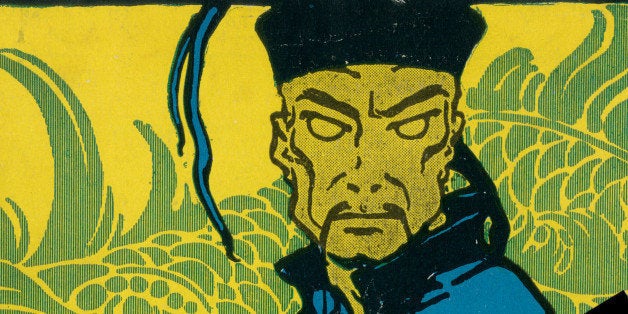
Imagine a super-villain who operates from within an underground hideout, strikes at the heart of empire through a suicide cult of footsoldiers who see each murder as a steppingstone to paradise, revels in refined forms of torture, broadcasts his intentions to politicians in advance and has dreams of world domination.
Familiar? No, not Osama Bin Laden but Dr. Fu Manchu, the Chinese villain of a series of thirteen novels and several short stories, who made his first appearance in 1913 with The Mystery of Dr Fu Manchu/The Insidious Dr Fu Manchu and his last in 1959 with Emperor Fu Manchu. Each novel takes place roughly in the present day when it was written and chronicles the never-ending struggle between Sir Denis Nayland Smith -- an ex-District Commissioner, late of Burma, now working for Scotland Yard, and often with transatlantic colleagues -- and Dr. Fu Manchu: a bit like racialised Sherlock Holmes stories.
The series begins just after the overthrow of the Manchu dynasty in 1911, and ends in Maoist China. The author responsible for creating the devil doctor was one Arthur Henry Ward, born into an Irish family in Birmingham, England -- much better known by his pseudonym of "Sax Rohmer," which he thought meant "freelance" in old Anglo-Saxon and certainly had an exotic ring to it.
Sax Rohmer, who incidentally had never been to China, was one of the best-selling authors of the first half of the twentieth century, with movies, radio shows, cartoons, comics, magazine serials, and even breakfast cereal packets, regularly adapted from his work. Dr. Fu Manchu was played, in movie versions, by the Irish-born Harry Agar Lyons, the Swedish-born Warner Oland, the English-born Boris Karloff, the German-born Henry Brandon, and the English-Italian Christopher Lee. Needless to say, he was never played by a Chinese actor.
Rohmer's favored actor for the part was "Basil Rathbone -- because he could be sinister even in his pajamas." As a result of this multi-media exposure, Dr. Fu Manchu lingered -- and lingers -- in the popular consciousness, more than any other twentieth century fictional bad guy, as the ultimate personification of oriental villainy, or as Rohmer put it, "the Yellow Peril incarnate in one man": inscrutable, fiendishly cunning, chillingly polite, cruel, indestructible and with a very long memory. Many of the anxieties of Chinaphobes in the West -- about Chinese ambitions overseas and Chinese communities at home -- have been distilled into one larger-than-life figure. We all like to personify our anxieties in this way, giving them a single face: it makes them easier to label and identify, less diffuse and complicated. Look at Osama Bin Laden. Or in fiction Dr. Fu Manchu. Although Sax Rohmer died -- of Asian flu would you believe? -- in 1959, his creation has long outlived him.
Shortly before the Hong Kong handover, in 1997, an article appeared in Newsweek -- by James R Lilley, CIA Station Chief in Beijing from 1973-1975, U.S. Ambassador to China 1989-1991 -- entitled "The Fu Manchu Problem: Why America and China tend to see each other as cartoonlike enemies." "Columnists and Congressmen," Lilley wrote, "portray the Chinese as rabid abortionists and iron-fisted thugs -- a gang of Fu Manchus who relish ripping out their enemies' fingernails. The hostility is very much on peoples' minds throughout the culture." The political rhetoric of China-bashing was, he added, deeply embedded in Western political life. And Fu Manchu provided an off-the-shelf piece of shorthand to express it.
His conclusion was that there was nothing to be gained by reviving old fears about the "Yellow Peril" in updated form. Chris Patten, the last Governor of Hong Kong, has confirmed that age-old stereotypes tend to get in the way of sensible dialogue -- even today. Dr. Fu Manchu made his first entrance just over a hundred years ago. Popular attitude towards China -- and Chinese people -- in the West have gone through many permutations in the meantime: friend in the Second World War, foe in the Cold War, potential rival today. China is now accessible, the sun has long since set on the British Empire, and many of the stereotypes which were acceptable yesterday have either been discredited or reclaimed by their opposites: Eve by feminists, Caliban by post-colonials, macho signifiers by gay rights. What about the Yellow Peril, personified by Dr. Fu Manchu? Has it survived the rise of China as a global superpower and the opening up of China to foreign tourists? Does the colonial, white, racist view of Chinese people persist?
Scare stories about Chinese perfidy continue to fill newspaper columns, financial pages and tabloid headlines alike. Some politicians play to Chinaphobia to gain popular approval. Strategists talk and write of the "Coming China Wars" over Taiwan or South Korea or the islands off South Japan or even Africa. Buried just beneath the surface of acceptable discourse lies the deep long history of the Yellow Peril -- like a reflex. Will Dr. Fu Manchu be reclaimed, to become a positive role model after all -- as his near contemporary Count Dracula has been reclaimed, in the era of Twilight? Only time will tell. At present, he serves a much darker purpose.
Sir Christopher Frayling is the author of The Yellow Peril: Dr. Fu Manchu and the Rise of Chinaphobia, just published by Thames and Hudson.